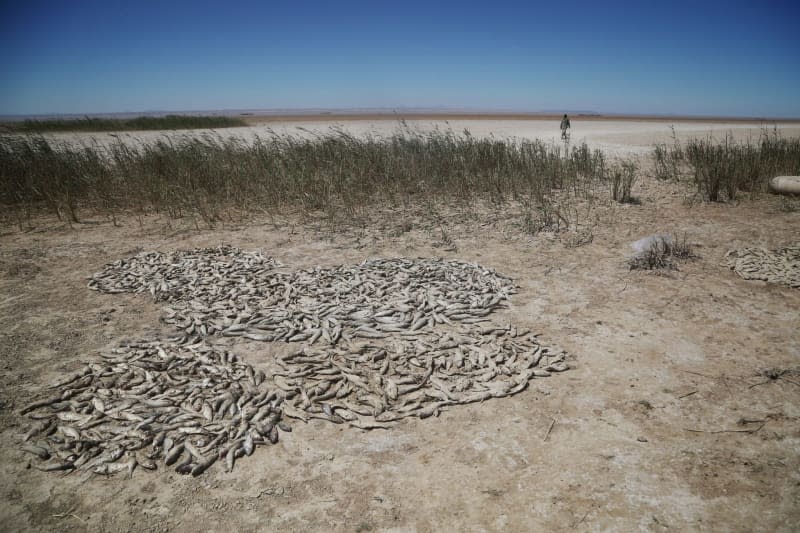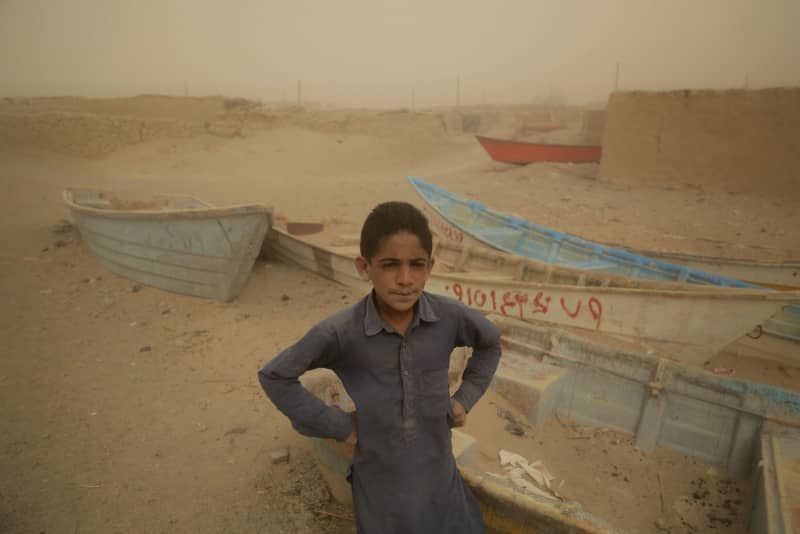Burning heat, sandstorms and drought plague those whose homes are in the areas along the border of Afghanistan and Iran.
Water can sometimes be so scarce in these provinces that it has to be brought to villages by tanker.
The region became a deadly battlefield earlier this year, with exchanges of fire days after Iranian President Ebrahim Raisi threatened the Afghan Taliban in a dispute over water from a major river.
The Lake Hamun biosphere reserve is not far from the border posts. Old photos of the ecosystem with its glistening water surface and flamingos are a reminder of the beauty of what was once the third largest lake in Iran.
It is now a barren scene of dried-up fish and abandoned boats.
The drought in the region is partly due to a dam in Afghanistan of the 1,000-kilometre Helmand River which flows into Lake Hamun. “For many years, the people in the north of the province benefited from the Helmand water and practised agriculture, fishing and livestock farming,” says Iranian lawmaker Mohammed Sargasi. Many residents have since moved away.
An agreement from 1973 regulates the use of the Helmand water – but is no longer enforced. Afghanistan is also affected by drought due to global warming. “We don’t even have enough water to drink,” says a resident of Nimrus province.
The prestige project supplies the province with electricity and is used to irrigate agriculture.
Better cooperation might help, says Lena Partzsch, professor of political science at Germany’s Free University. “If water wars occur, it’s more of a self-fulfilling prophecy,” she says.
“I’m not pessimistic because I think that water is first and foremost a resource that promotes cooperation,” she adds.
A sign of this was when the Taliban travelled to Iran last year in the dispute over Helmand. “It would be important to create a space for negotiations and institutions instead of investing in armaments,” says Partzsch, whose research focuses on environmental issues.
Climate change, changing water resources – we have to adapt to this, says Partzsch. “Not just technically, but in harmony with people and nature.”
An Afghan water expert is promoting better cooperation. “The evaporation rate is high in Sistan and Balochistan,” says Najibullah Sadid, of Germany’s Federal Waterways Engineering and Research Institute(BAW).
He sees prospects for closer cooperation especially in agriculture. “It makes sense to grow crops where it works. Water wastage must be prevented.”
Water’s explosive power in the political arena is also evident in north-east Africa.
Egypt fears for its water supplies and domestic farming once Ethiopia’s Nile dam, set to be the largest in Africa, is completed in 2024 or 2025.
Egypt meets more than 90% of its water needs from the Nile and the dispute over how the reservoir will be filled and how much water will flow down the river in the future has already come close to military escalation on several occasions, if words are any indication.
Egyptian President Abdel Fattah al-Sisi, initially conciliatory, is slowly losing patience as the dispute drags on. As Cairo sees it, Ethiopia is refusing to mediate and is playing for time.
“Let’s not reach a point where [the brothers in Ethiopia] touch a drop of Egyptian water, because all options are on the table,” said al-Sisi. “Unthinkable instability in the region” could otherwise follow.
Sudan, located between Egypt and Ethiopia, is also affected and the power struggles there are an additional complication when it comes to mediation efforts. The president backed by the army has been wrestling with the former vice president and his Rapid Support Forces (RSF) militia for leadership.
The situation in Khartoum makes a three-way agreement in the tug-of-war with Cairo and Addis Ababa virtually impossible.
Several shared rivers are also at the core of disputes between India and Pakistan, both facing water shortages and beset by drought. The best known river is the Indus – Pakistan’s most important river, flowing from Tibet through the Indian part of Kashmir.
A cooperation agreement brokered by the World Bank was established 60 years ago and was seen as a glimmer of hope, given that the two nuclear-armed nations have faced off in several wars over other conflicts.
But India suddenly demanded a change to the agreement earlier this year – in a further dam-related dispute.
Pakistan sees India’s hydropower projects in the Kashmir region as a problem for its water supply. “The agreement was a great agreement in the 1960s,” says a government official in Islamabad, having survived wars and political tensions. Today there are new challenges. India, on the other hand, says Pakistan is refusing to compromise.
Pervaiz Amir, a climate specialist in Pakistan, is calling for a rapid rethink. “Considering that all the glaciers in the northern regions of Pakistan and India will disappear by the end of this century if they continue to melt at the same rate, and that they are the main source of water in the rivers, Pakistan and India need to talk to each other now,” says Amir.
“It’s a purely technical problem, but one that has the potential to cause conflict or even war in the future.”







